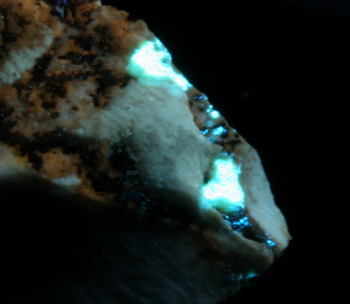Database of luminescent minerals
IDRIALITE
Chemical formula: C22H14
Family: Organic
Status: IMA-GP
Crystal system : Orthorhombic
Display mineral: NON
Associated names (luminescent varieties, discredited names, synonyms, etc.): curtisite,
Luminescence:
Longwave UV (365nm) colors: |
Bluish White , Yellowish White , Greenish Yellow , Bluish Green , Greenish white , | ||
Intensity LW:Very Strong | Frequency LW:Always | ||
Midwave UV (320nm) colors: |
Greenish white , Greenish Yellow , Green , Greenish , Bluish Green , Greenish white , | ||
Intensity MW:Very Strong | Frequency MW:Always | ||
Shortwave UV (254nm) colors: |
Greenish white , Bluish White , Greenish Yellow , Green , Greenish , | ||
Intensity SW:Very Strong | Frequency SW:Always | ||
Daylight picture

IDRIALITE,
Hernik mine, East Slovakia, 3.5 cm wide
Photo and Copyright: Paul Garland
Pictures on Flickr:
http://www.flickr.com/groups/fluorescent-minerals/pool/55922094@N00/
Used with permission of the author
Shortwave (254nm) picture

IDRIALITE under UVSW,
Hernik mine, East Slovakia, 3.5 cm wide
Photo and Copyright: Paul Garland
Pictures on Flickr:
http://www.flickr.com/groups/fluorescent-minerals/pool/55922094@N00/
Used with permission of the author
Pictures Galery:


 ...
...Do you have a photo of this mineral you would like to see in the gallery? Contact us!
Phosphorescence (in the common sense of the term) observable with the naked eye:
No data
Comments:
Identical to dimethylbenzphenanthrene (Handbook of Mineralogy) but possibly a complex mixture of polycyclic aromatic hydrocarbons (PAH). Raman spectroscopy studies indicate that it may be a mixture of complex hydrocarbons including benzonaphthothiophenes (chemical formula: C16H10S) and dinaphthothiophenes (chemical formula: C20H12S) Approximate abundance of PAHs contained in idrialite from Skaggs Springs (Wise et al. 1986) : picene [40%], chrysene [7%], benzo-phenanthro-thiophene [10%], dibenzo-carbazole [trace], dibenzo-fluorene [33%], indeno-fluorene [7%], and benzo-indeno-fluorene [4%]. Potentially dangerous substance: the PAH contened in Idrialite are toxic.
Activator(s) and spectrum:
Activator(s): Matière organique intrinsèque,
Peaks in the spectrum (nm):
Peaks at: 454nm, 482nm, 512nm, 544nm, 597nm ;

Col. G. Barmarin; Spectre: G. Barmarin
Spectrum Galery:



 ...
...Comments on spectrum and activators:
Blue luminescence due to the two linearly annelated benzene rings characteristic of aromatic compound (singlet-singlet electron transition within the benzene rings.Spectral lines (cm-1): 250, 235, 222, 208;
Best localities for fluorescence (*):
- Skaggs Springs Mine, Skaggs Springs, Warm Springs Dam, Coast Range, Sonoma Co., California, USA;
- Hg deposit, Idria, Kraina, Slovenia, former Yugoslavia;
- Culver-Baer Mine, North Fork Little Sulphur Creek, Cloverdale, West Mayacmas District, Mayacmas Mts, Sonoma Co., California, USA;
- Great Western Mine, Great Western-Mirabel group, Middletown, East Mayacmas District, Mayacmas Mts, Lake Co., California, USA;
- Merník, Vranov nad Topľou Co., Prešov Region, Slovakia;
(*)The data are not exhaustive and are limited to a few remarkable localities for fluorescence
Bibliographic reference for luminescence:
- The Henkel Glossary of Fluorescent Minerals, Dr. Gerhard Henkel, Published by the FMS, 1989 ,
- Fluorescence: Gems and Minerals Under Ultraviolet Light, Manuel Robbins, 1994, Geoscience Press, ISBN 0-945005-13-X ,
- Luminescent Spectra of Minerals, Boris S. Gorobets and Alexandre A. Rogojine, Moscow, 2002 ,
Reference for luminescence on the Internet:
- The crystal structure, origin, and formation of idrialite (C22H14): Inferences from the microbeam and bulk analyses, Akuya Echigo, Mitsuyoshi Kimata, Teruyuki Maruoka, Masahiro Shimizu, and Norimasa Nishida, American Mineralogist, Volume 94, pages 1325–1332, 2009
- https://www.mindat.org/min-2003.html
- http://www.handbookofmineralogy.com/pdfs/idrialite.pdf
Images:
- Skaggs Springs Mine, Ca, USA: http://www.mindat.org/photo-263000.html
- Culver-Baer Mine, California, USA: http://www.mindat.org/photo-429039.html
Mineralogical reference on the Internet:
 http://www.mindat.org/show.php?name=Idrialite
http://www.mindat.org/show.php?name=Idrialite
 http://webmineral.com/data/Idrialite.shtml
http://webmineral.com/data/Idrialite.shtml
Internet Search:
 Image search on 'Google Images'
Image search on 'Google Images'
 Search for documents in all languages on Google
Search for documents in all languages on Google
A request providing no result means only that no such reference exists in the database, but it does not mean that what you are looking for does not exist, just not to our knowledge. If you think you have found an error or omission, please let us know via the contact page being sure to cite the source of information.

